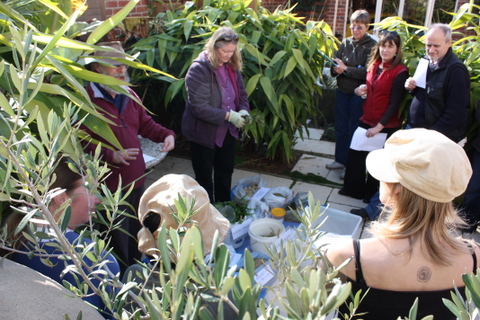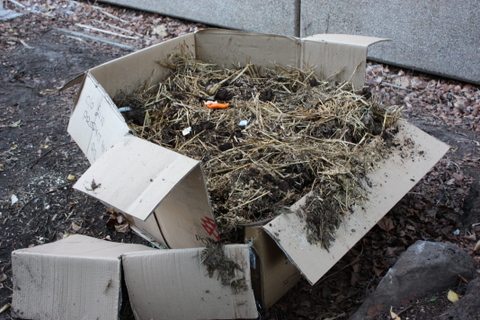
Yesterday (Sunday), my local permaculture group gathered for our monthly meeting. This month’s topic was on Composting. I put my hand up this time to host the event, because I don’t grow many fruit trees etc, or have chickens or an amazing vege patch (like some I have seen), but one thing I can do is decompose things. Well…I can sort of decompose them, which is why I am interested in knowing how to do it even better.
Ross and Wendy Mather from St Andrews were our presenters, and they have had many years experience growing their own food and making their own compost, and for the dry clayey soils in St Andrews, this is an essential skill. Ross and Wendy also present to local councils and the like about the art and science of composting.
So, firstly, one of the big tips I got out of today was the following – one very good reason to compost is that if you put any scraps in your rubbish, and then they get buried under piles of trash and plastic and old washing machines etc, and bulldozed over with soil at the tip, it creates anaerobic conditions (basically meaning there is no oxygen) and this creates methane, which is about 5 times worse than Carbon dioxide (which causes the greenhouse effects). So, not composting and turning a blind eye creates an even bigger problem.
And a second great reason to compost is that your soil loves it, and all the worms and microbes in the soil will rejoice, and your plants will grow, and you will live happily ever after (you get the drift).
So, what can you compost. Well, in the past I was leaving citrus peels and onions out of the compost, and certainly not adding meat or cheese (my compost was vegan), but apparently you can compost anything that has been living in your lifetime (as long as you don’t try to compost a whole cow in your tumble bin you should be right). So that’s good news. I hate throwing organic matter in the bin.
Also, another rule is that if you compost anything – break it up into smaller pieces and this will speed up the process (for instance a whole cow will take some time to decompose, whereas in pieces it will take way less time).
I have also been pretty random with my composting, not really paying much attention to the ratios of what I add, but I have discovered today that I need to pay more attention to the science. And here are the rules – which are simple (and my brain likes simple).
Ingredients
- Start with one bucket of food scraps, or freshly cut grass or weeds.
- To this, add a similar amount of nitrogen filled substance (manure, guinea pig poo, hair, toe nail clippings, comfrey leaves). As it is hard to tell what nitrogen filled substances look like – think of it this way. If it’s fresh and green (fresh manure) then it’s high in Nitrogen. If it’s been around for a long time, it’s most likely lost it’s nitrogen.
- To this put two parts of carbon filled substance on top of this (ie two small buckets of straw, dried grass, paper, dried leaves, sawdust, sugarcane or mulch).
- And when you build your compost, think lasagna – one layer of green, one layer of dry, and so on.
So that’s it. It’s not rocket surgery, but it will take me to be a bit more methodical in building my compost. In the past I threw in the scraps, I threw in some guinea pig manure, but my compost usually looks like swelch.
So next time I waltz outside with my scraps and put them in the compost bin, I also need to add some guinea pig poop, and double the amount I have just added with some dry ‘carbon filled’ materials. Also add a bit of water (maybe half of a container of water to keep it moist). Then let the microbes do their thing.
Turn and don’t turn
So, what next? Do you wait for 6 months, do you turn your compost on a daily basis? Well, here’s some of the information I gleamed yesterday.
Ross and Wendy discussed different techniques – whether you rotate the compost or just leave it, and what I learnt from this is you can do either of these things, rotating the compost may increase the process. Personally, I am happy to wait, glass of Sav blanc in hand and watch my rotating compost bin swinging in the breeze than expend too much energy.
Our composting demo
As part of yesterday’s training, Ross and Wendy built a compost sample in the back lane. Butting up against a local building (ACER), there is a makeshift garden established by ACER staff. We found some cardboard boxes to give the compost structure, and Ross and Wendy put some sticks in the bottom of the boxes to aerate the compost heap.
Then they put layer and layer of weeds, manure and straw/paper/sawdust on top.
I am going to take photo’s over the next few weeks and add them to this blog to review the progress, until the temperature is down and we have some nice soil. So here goes:
Day 1 – Sunday 8th August
Nothing much to report except the existance of a compost heap. I had to put a note on it for the ACER guys…or else they would really be wondering.
Day 2 – Monday 9th August
Spoken to the ACER guy and he loves the fact that a compost heap has sprung in his lane way. I took the temperature today, and at 16 degrees C, there isn’t any microbe action yet.
Stay turned for more stinking action!
Jump to Day 6.



Had a good laugh at the bit about the cow in the compost! Thanks for blogging this, I was sorry to miss out but will follow the heap with interest. Let me know when the temperature of the compost reaches frothing temperature!!!
LikeLike
Hey – Thanks for the update – I missed this one (very sad) but feel almost like I was there!
Keep us posted on the ‘post progress!
Kaz
LikeLike